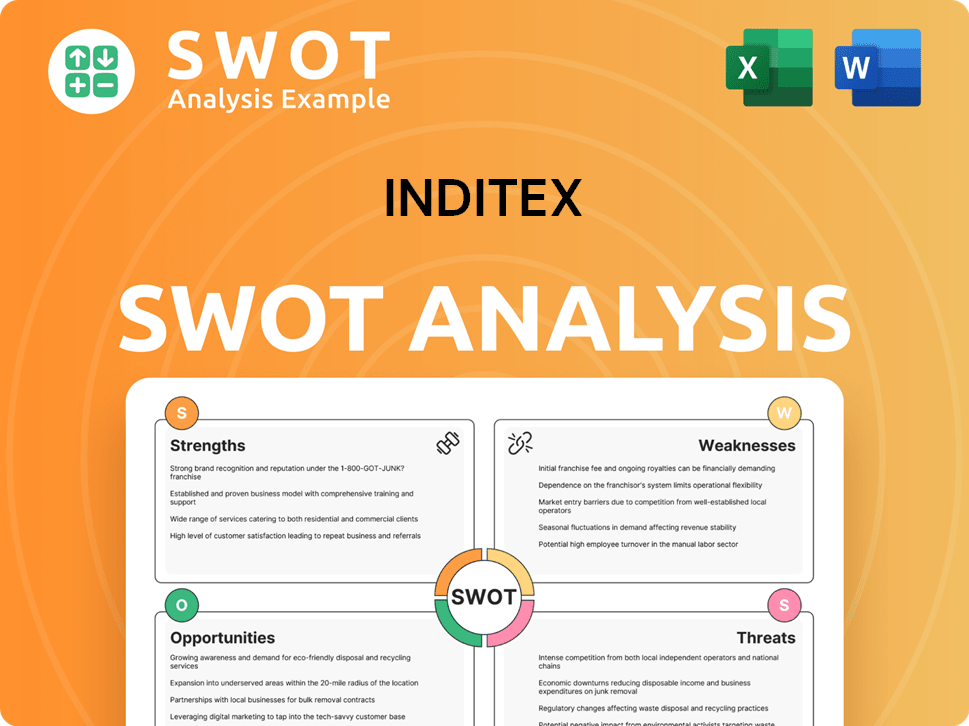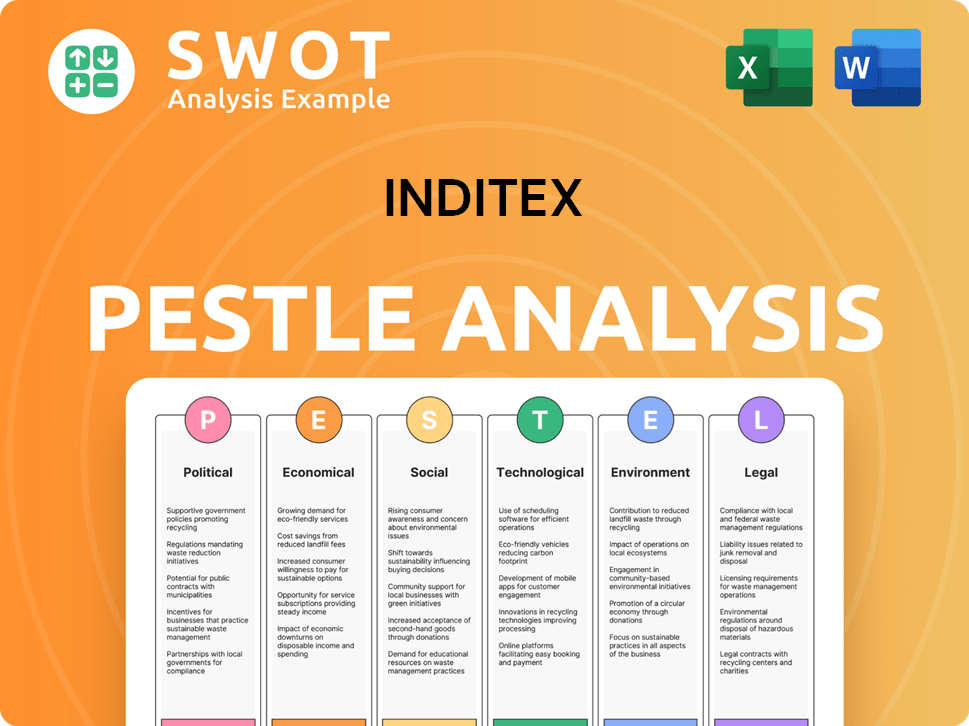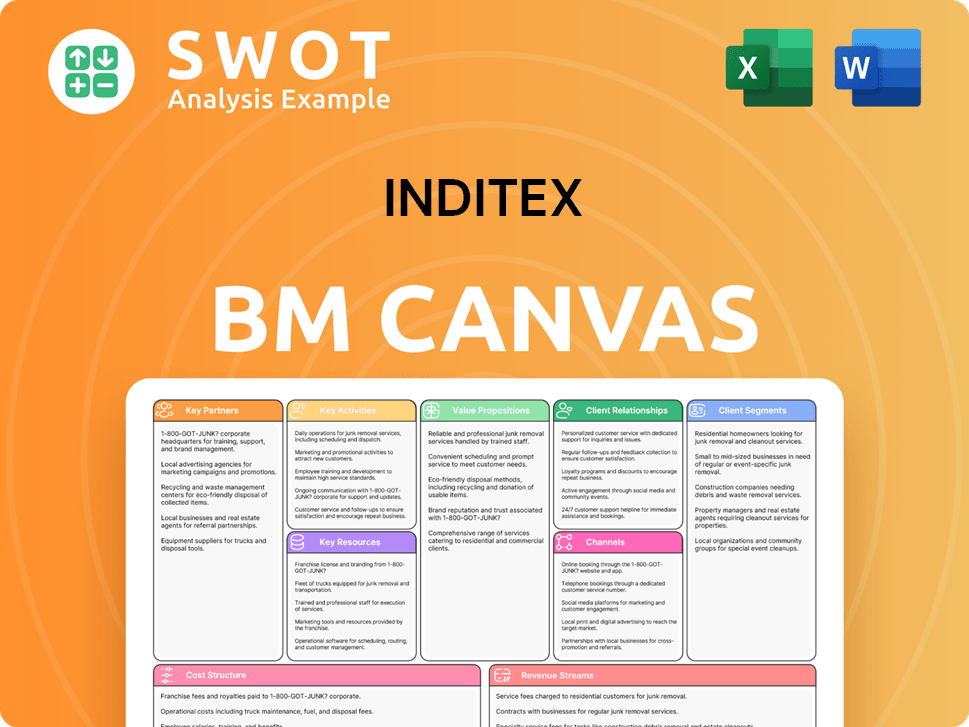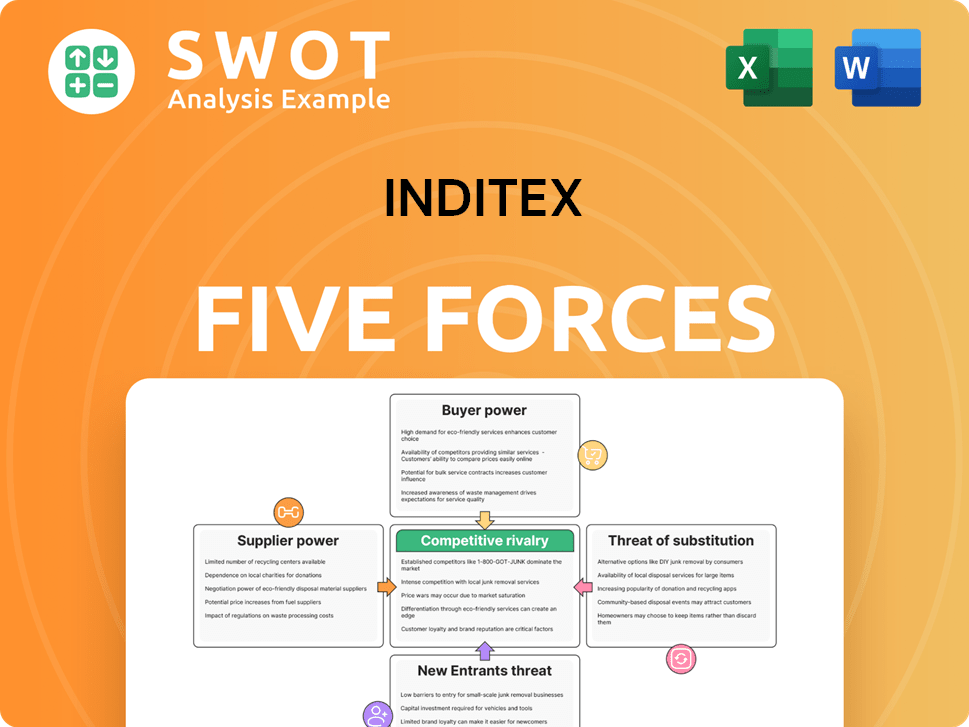Inditex Bundle
Who Buys Fashion from Inditex?
In today's fast-paced retail environment, understanding customer demographics is paramount for success. Inditex, the fashion giant behind Zara and other brands, has masterfully adapted its strategies to cater to a diverse global audience. This in-depth analysis explores the Inditex SWOT Analysis, customer profiles, and market segmentation that drive its enduring appeal and competitive advantage.

From its origins in Spain to its global presence, Inditex's ability to pinpoint and serve its target market has been key to its growth. We'll delve into the specifics of Inditex's customer demographics, including age range, income levels, and fashion preferences. This exploration of Inditex's consumer behavior will provide valuable insights for anyone interested in retail strategy and market analysis, showing how the company continuously refines its approach to meet the evolving demands of its customers.
Who Are Inditex’s Main Customers?
Understanding the customer demographics and target market of the Inditex company is crucial for grasping its success. Inditex, operating primarily on a business-to-consumer (B2C) model, caters to a diverse range of customers through its various brands. Each brand within the Inditex portfolio has a distinct target market, reflecting different fashion preferences, age groups, and income levels.
The Inditex customer profile is segmented by brand, with Zara being the flagship, targeting fashion-conscious individuals aged 18-40. Pull&Bear focuses on a younger demographic, typically 13-25 years old, while Massimo Dutti appeals to a more mature and affluent customer base. This market segmentation strategy allows Inditex to capture a broad spectrum of consumers, ensuring its continued relevance in the fast-paced fashion industry. To learn more about the company, check out this Brief History of Inditex.
The company's ability to adapt to evolving fashion trends and consumer demands is key to maintaining its competitive edge. For instance, the increasing emphasis on sustainable collections across brands like Zara and Massimo Dutti reflects a response to growing consumer awareness of environmentally friendly practices, particularly among younger, socially conscious consumers. This adaptability is crucial for the company's long-term success.
Zara's target market consists of fashion-conscious individuals aged 18-40. These customers typically have a mid-to-high income level and seek trendy, affordable, and high-quality apparel. They value the rapid turnover of styles and a seamless shopping experience, driving significant growth for the brand.
Pull&Bear targets a younger demographic, generally 13-25 years old. This segment is focused on casual, urban, and youthful fashion, often at a more accessible price point. The brand's appeal lies in its ability to stay connected with the latest youth trends.
Bershka also targets a similar age group to Pull&Bear but with a more edgy and trend-driven aesthetic. The brand focuses on providing the latest fashion trends to its young customer base, keeping up with the fast-paced nature of the fashion industry.
Massimo Dutti appeals to a more mature and affluent customer, aged 25-50. This segment seeks sophisticated, classic, and high-quality clothing for both professional and casual wear, indicating a higher income and a preference for timeless elegance.
Inditex's success lies in its ability to cater to diverse customer preferences through its brand portfolio. Each brand’s customer demographics are carefully considered to align with specific fashion tastes, age groups, and income levels. This tailored approach allows Inditex to maximize its market reach and maintain a strong competitive position.
- Zara: Fashion-conscious, mid-to-high income, trendy apparel, ages 18-40.
- Pull&Bear: Young, casual, urban fashion, ages 13-25.
- Bershka: Edgy, trend-driven fashion, ages 13-25.
- Massimo Dutti: Sophisticated, classic, high-quality clothing, ages 25-50.
Inditex SWOT Analysis
- Complete SWOT Breakdown
- Fully Customizable
- Editable in Excel & Word
- Professional Formatting
- Investor-Ready Format

What Do Inditex’s Customers Want?
Understanding the customer needs and preferences is crucial for the success of any retail giant, and for the case of Inditex, this is particularly true. The company's ability to quickly adapt to changing fashion trends and consumer demands is a key factor in its market leadership. This customer-centric approach allows Inditex to maintain a competitive edge in the fast-paced world of fashion retail.
Inditex's diverse brand portfolio caters to a wide range of customer segments, each with unique preferences and purchasing behaviors. By analyzing the Inditex customer profile, the company can tailor its product offerings, marketing strategies, and overall customer experience to meet the specific needs of each segment. This targeted approach enhances customer satisfaction and fosters brand loyalty.
The core of Inditex's strategy revolves around providing current fashion trends at accessible price points. Customers are driven by a desire for novelty and frequent updates, which fuels high purchasing frequency. This 'fast fashion' model addresses the psychological need for immediate gratification and the aspiration to stay abreast of the latest styles without significant financial commitment. Decision-making criteria often include design, perceived quality, price, and the ability to quickly acquire new items.
Inditex's success is built on understanding and catering to the diverse needs of its customer base. The company's ability to adapt to changing trends and consumer demands is a key factor in its market leadership. Here are some of the key factors:
- Fashion Trends: Customers seek the latest styles, driving the need for frequent updates and new collections.
- Price: Accessible price points are crucial, making fashion available to a broad customer base.
- Quality: Customers expect a certain level of quality, influencing their purchasing decisions.
- Convenience: Easy access to products, both in-store and online, enhances the shopping experience.
- Brand Image: Customers are influenced by brand reputation and the perceived value associated with each brand.
Inditex PESTLE Analysis
- Covers All 6 PESTLE Categories
- No Research Needed – Save Hours of Work
- Built by Experts, Trusted by Consultants
- Instant Download, Ready to Use
- 100% Editable, Fully Customizable

Where does Inditex operate?
Inditex has a robust geographical market presence, with its brands strategically located across numerous countries. Europe, particularly Spain, is a core market, with significant brand recognition. The company also has a strong presence in North America and a growing footprint in Latin America. Asia, especially China and Japan, is another crucial market for Inditex.
This widespread presence allows Inditex to cater to diverse customer demographics and preferences. The company adapts its strategies to suit regional tastes, including product assortments, marketing campaigns, and store layouts. This localization is essential for resonating with Inditex's target market in different regions.
Recent expansions have focused on strengthening the online presence globally, complementing the physical store network. This dual strategy includes solidifying existing strongholds and capturing new digital frontiers. In fiscal year 2024, Inditex reported 32.5 billion euros in net sales, with substantial contributions from international operations, highlighting the success of its geographically diversified strategy.
Europe remains a crucial market for Inditex, with Spain, its home country, holding significant market share. Other major European markets include France, Italy, Germany, and the UK. These countries feature prominent retail locations for Inditex brands. Inditex's success in Europe is a cornerstone of its global strategy.
Inditex has a strong foothold in North America, particularly in the United States and Canada. The company is also expanding its presence in Latin America, with countries like Mexico and Brazil contributing significantly to sales. These regions are crucial for future growth.
China and Japan are vital markets in Asia for Inditex. The company is also exploring emerging opportunities in Southeast Asia. This strategic focus highlights Inditex's commitment to expanding its global reach and capturing new Inditex customer profile.
Inditex is strengthening its online presence globally to complement its physical store network. This strategy includes optimizing its store footprint, with strategic closures of less profitable stores. E-commerce growth is accelerating in emerging economies, reflecting a dual strategy.
Inditex addresses regional differences by empowering local teams to adapt product assortments. This includes marketing campaigns and store layouts to suit regional tastes. Collections may feature different color palettes or silhouettes to align with local fashion trends.
Marketing efforts are localized, utilizing relevant social media platforms and local influencers to connect with regional audiences. This approach ensures that marketing messages resonate with the specific Inditex consumer behavior of each target market. This approach helps to build brand loyalty.
E-commerce is a key growth area, especially in emerging markets. This expansion complements the physical store network, offering customers more convenient shopping options. The focus on e-commerce reflects changing Inditex customer buying habits.
Inditex optimizes its store footprint, including strategic closures of less profitable stores. This allows the company to enhance overall efficiency. The goal is to maximize profitability and provide a better shopping experience for customers.
In fiscal year 2024, Inditex reported 32.5 billion euros in net sales. International operations contributed significantly to this figure, underscoring the success of its geographically diversified strategy. This demonstrates the effectiveness of Inditex's global approach.
The differences in customer demographics, preferences, and buying power across regions significantly influence Inditex's approach. For instance, while the desire for fast fashion is global, specific design preferences and cultural sensitivities necessitate localization. To learn more about how Inditex targets its customers, read this article about the Inditex company analysis.
Inditex Business Model Canvas
- Complete 9-Block Business Model Canvas
- Effortlessly Communicate Your Business Strategy
- Investor-Ready BMC Format
- 100% Editable and Customizable
- Clear and Structured Layout

How Does Inditex Win & Keep Customers?
The company's customer acquisition and retention strategies are multifaceted, leveraging both digital and traditional channels. They focus on attracting customers through robust digital campaigns and a global store network. These strategies are designed to create a sense of urgency and encourage frequent visits, essential for driving sales and building brand loyalty.
Digital marketing, including social media campaigns on platforms like Instagram, TikTok, and Facebook, is a cornerstone of their customer acquisition efforts. Traditional advertising, such as placements in fashion magazines, also plays a role, though to a lesser extent. The company emphasizes providing a compelling customer experience, integrating online and offline shopping for convenience.
Retention strategies center on delivering a consistent and engaging customer experience, including personalized recommendations and seamless online-offline integration. While formal CRM systems are utilized, segmentation is often implicit, driven by brand identity and product offerings. Successful campaigns frequently involve viral social media challenges and collaborations with influencers, generating significant buzz and reach.
The company heavily relies on digital marketing, especially on social media platforms like Instagram and TikTok, to reach its target market. These campaigns showcase new collections and drive significant traffic to both online and physical stores. This digital-first approach enhances customer loyalty and lifetime value.
A key acquisition tactic is the rapid introduction of new styles, which creates a sense of urgency and encourages frequent visits. This strategy is central to the company's business model, ensuring that stores always have fresh products to attract customers. This helps in keeping customers engaged.
The company enhances customer retention through personalized recommendations on its online platforms. These suggestions are based on past purchases and browsing history. This helps in creating a tailored shopping experience.
The company integrates online and offline shopping through services like click-and-collect and in-store returns for online purchases. This enhances convenience for customers. This encourages repeat engagement and increases customer satisfaction.
The company's approach to customer acquisition and retention is dynamic, adapting to evolving consumer behaviors and market trends. The integration of digital channels has significantly impacted customer loyalty and lifetime value, offering greater convenience and personalized interactions. For more insights, you can read about the Growth Strategy of Inditex.
Email marketing campaigns are tailored to specific brands within the company. For example, Zara's emails highlight the latest trends, while Massimo Dutti focuses on classic elegance. This targeted approach ensures that communications resonate with the intended audience.
Successful acquisition campaigns frequently involve collaborations with high-profile fashion influencers. These collaborations generate significant buzz and reach, attracting new customers. This strategy is particularly effective on social media platforms.
The company uses exclusive online collections and early access to sales for app users to foster a sense of exclusivity. This rewards engagement and encourages repeat purchases. This helps in building customer loyalty.
While the company utilizes CRM systems, segmentation is often implicit, driven by brand identity and product offerings. This approach allows for targeted marketing campaigns. This helps in creating more effective campaigns.
The company has increasingly shifted its focus towards digital channels for both acquisition and retention. This digital-first strategy aligns with the growing trend of online shopping. This impacts customer loyalty and lifetime value.
The company's focus on digital channels and personalized interactions has significantly impacted customer loyalty and lifetime value. This approach offers greater convenience and personalized interactions. This helps reduce churn rates.
Inditex Porter's Five Forces Analysis
- Covers All 5 Competitive Forces in Detail
- Structured for Consultants, Students, and Founders
- 100% Editable in Microsoft Word & Excel
- Instant Digital Download – Use Immediately
- Compatible with Mac & PC – Fully Unlocked

Related Blogs
- What are Mission Vision & Core Values of Inditex Company?
- What is Competitive Landscape of Inditex Company?
- What is Growth Strategy and Future Prospects of Inditex Company?
- How Does Inditex Company Work?
- What is Sales and Marketing Strategy of Inditex Company?
- What is Brief History of Inditex Company?
- Who Owns Inditex Company?
Disclaimer
All information, articles, and product details provided on this website are for general informational and educational purposes only. We do not claim any ownership over, nor do we intend to infringe upon, any trademarks, copyrights, logos, brand names, or other intellectual property mentioned or depicted on this site. Such intellectual property remains the property of its respective owners, and any references here are made solely for identification or informational purposes, without implying any affiliation, endorsement, or partnership.
We make no representations or warranties, express or implied, regarding the accuracy, completeness, or suitability of any content or products presented. Nothing on this website should be construed as legal, tax, investment, financial, medical, or other professional advice. In addition, no part of this site—including articles or product references—constitutes a solicitation, recommendation, endorsement, advertisement, or offer to buy or sell any securities, franchises, or other financial instruments, particularly in jurisdictions where such activity would be unlawful.
All content is of a general nature and may not address the specific circumstances of any individual or entity. It is not a substitute for professional advice or services. Any actions you take based on the information provided here are strictly at your own risk. You accept full responsibility for any decisions or outcomes arising from your use of this website and agree to release us from any liability in connection with your use of, or reliance upon, the content or products found herein.